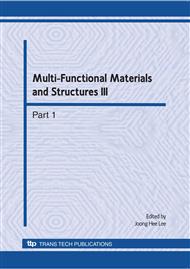p.256
p.260
p.264
p.268
p.272
p.276
p.280
p.284
p.291
The Inhibition Effect of TiO2/Ag Thin Film on Acinetobacter baumannii
Abstract:
The nosocomial infections caused by opportunistic pathogen Acinetobacter baumannii was increasing in recent years. It was known that the attachment of A. baumannii on solid surface was a key factor for infection. This study was conducted to evaluate the inhibitory effect of titanium dioxide (TiO2)/Ag thin film on A. baumannii. In this study, TiO2 thin films were firstly prepared by using the modified impregnation method, then TiO2/Ag thin films were prepared by using the spin-coating with 5000 ppm Ag+. The TiO2/Ag thin film was analyzed by field-emission scanning electron micrographs and X-ray diffractometer. The nano-size and Anatase crystal structure were confirmed. Twenty clinical A. baumannii isolates were examined for the bactericidal effect of TiO2/Ag thin film either in the dark or under visible light activation for 20 min. The inhibition efficiencies of TiO2/Ag thin film under visible light on these 20 isolates ranged from 41% to 90%. The effects of TiO2/Ag thin film in the dark were slightly lower than visible light-activated group. Our results suggested that coating of TiO2/Ag on solid surface in hospital environment might be helpful for the prevention of nosocomial A. baumannii infection.
Info:
Periodical:
Pages:
272-275
Citation:
Online since:
August 2010
Authors:
Price:
Сopyright:
© 2010 Trans Tech Publications Ltd. All Rights Reserved
Share:
Citation:


